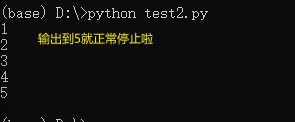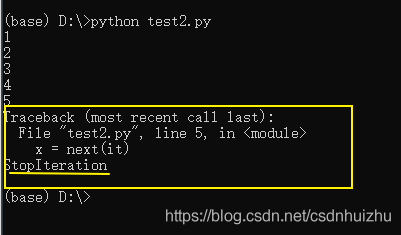python 异常处理 StopIteration
- 有StopIteration的情况
- 没有StopIteration的情况
- 在next()中增加第二个参数
- 执行一次next()输出多少个元素:一个
-
- ==case one 以迭代器的形式==
- ==case two 以列表形式作为输入: 不可以==
- ==case three 以元组形式作为输入: 不可以==
- ==case four : 利用iter + for 可以==
- ==case five: (name for name in a)的数据类型到底是什么?:generator==
有StopIteration的情况
it = iter([1,2,3,4,5])
while True:
try:
x = next(it)
print(x)
except StopIteration:
break

这里退出while循环后还可以继续往下执行代码
没有StopIteration的情况
it = iter([1,2,3,4,5])
while True:
x = next(it)
print(x)

这里Traceback后就不能往下执行代码了
在next()中增加第二个参数
it = iter([1,2,3,4,5])
while True:
x = next(it,None)
print(x)
if x == None:
break
print("hahahaha")

执行一次next()输出多少个元素:一个
case one 以迭代器的形式
it = iter([1,2,3,4,5])
print(next(it,None))

case two 以列表形式作为输入: 不可以
it = [2,1,3,4,5]
print(next(it,None))

case three 以元组形式作为输入: 不可以
it = (1,2,3,4,5)
print(next(it,None))

case four : 利用iter + for 可以
it = iter([1,2,3,4,5])
a = next((name for name in it),None)
print(a)

case five: (name for name in a)的数据类型到底是什么?:generator
a = [1,2,3,4,5]
b = [4,5,6,7,8]
print(name for name in a if name not in b)
c = (name for name in a if name not in b)
print("the type of c:",type(c))
print("the output of next() function:",next(c,None))








